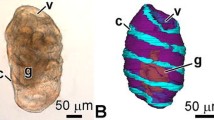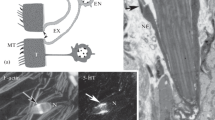Summary
Protonephridia are described at the electron microscopical level in the larvae of L. cinereus and A. papillosa. These nephridial organs are composed of one terminal cell, two (A. papillosa) or several (L. cinereus) duct cells, and one nephridiopore cell. In each case, the perikaryon of the terminal cell bears cilia, microvilli and a slashed cytoplasmic element (like a lobe in L. cinereus; like a hollow cylinder in A. papillosa), which functions as the supporting structure of the filtration barrier (ECM or diaphragm) and is desmosomally connected to the adjacent duct cell. Developmental aspects of the organs are described for L. cinereus. The description of protonephridia in larvae of a polyplacophoran permits a reevaluation of the nephridial design in larvae of molluscs: because of homologous correspondences to the protonephridia of other members of the Bilateria, larval protonephridia are postulated for the ground pattern of molluscs.
Zusammenfassung
Larvale Protonephridien werden bei L. cinereus und A. papillosa auf ultrastruktureller Ebene beschrieben. Die Organe bestehen jeweils aus einer Terminalzelle, zwei (A. papillosa) oder mehreren (L. cinereus) Kanalzellen und einer Nephroporuszelle. Die Terminalzelle ist multiciliär, besitzt Mikrovilli und ein geschlitztes cytoplasmatisches Element, das bei L. cinereus lappenförmig, bei A. papillosa als Hohlzylinder ausgebildet ist. Dieses cytoplasmatische Element fungiert als Trägerstruktur der Filtrationsbarriere (ECM bzw. Diaphragmata) und ist durch Desmosomen mit der folgenden Kanalzelle verbunden. Aufgrund homologer Übereinstimmungen der hier beschriebenen Protonephridien mit entsprechenden Organen anderer Bilateria sind larvale Protonephridien im Grundmuster der Mollusken anzunehmen.
Similar content being viewed by others
Literatur
Ax P (1984) Das phylogenetische System. Systematisierung der lebenden Natur aufgrund der Phylogenese. Fischer, Stuttgart
Bartolomaeus Th (1987) Ultrastruktur des Photorezeptors der Trochophora von Anaitides musosa Oersted (Phyllodicdae, Annelida). Microfauna Mar 3:411–418
Bartolomaeus Th (1988) No contact between the excretory system and the circulatory system in Prostomatella arenicola. Hydrobiologia 156:175–181
Brandenburg J (1966) Die Reusenformen der Cyrtocyten. Eine Beschreibung von fünf weiteren Reusengeißelzellen und eine vergleichende Betrachtung. Zool Beitr 12:345–417
Ehlers U (1985) Das phylogenetische System der Plathelminthes. Fischer, Stuttgart
Erlanger R v (1891) Beiträge zur Entwicklungsgeschichte der Gasteropoden. Mitt Zool Stat Neapel 10:376–407
Erlanger R v (1892) Zur Entwicklungsgeschichte von Paludina vivipara. I. Teil. Morph Jahrb 17:337–379
Goodrich ES (1945) The study of nephridia and genital ducts since 1895. Q J Microsc Sci 86:113–329
Hay-Schmidt A (1987) The ultrastructure of the protonephridium of the actinotrocha larva (Phoronida). Acta Zool 68:35–49
Holborow PL (1971) The fine structure of the trochophore of Harmothoë imbricata. In: The fourth european marine biological symposium. Cambridge University Press, S 237–246
Lammert V (1985) The fine structure of protonephridia in Gnathostomulida and their comparison within the Bilateria. Zoomorphology 105:308–316
Lauterbach K-E (1983) Erörterungen zur Stammesgeschichte der Mollusca, insbesondere der Conchifera. Z Zool Syst Evolutionsforsch 21:201–216
Meisenheimer J (1899) Zur Morphologie der Urniere der Pulmonaten. Z Wiss Zool 65:709–724
Meisenheimer J (1900) Zur Entwicklungsgeschichte von Dreissena polymorpha. Z Wiss Zool 69:1–137
Neuhaus B (1987) Ultrastructure of the protonephridia in Dactylopodola baltica and Mesodasys laticaudatus Macrodasyida): implications for the ground pattern of the Gastrotricha. Microfauna Mar 3:419–438
Salvini-Plawen L v (1980) Was ist eine Trochophora? Eine Analyse der Larventypen mariner Protostomier. Zool Jahrb Abt Anat Ontog Tiere 103:389–423
Stauffacher H (1897) Zur Urniere bei Cyclas cornea (Lam.). Z Wiss Zool 63:43–61
Author information
Authors and Affiliations
Rights and permissions
About this article
Cite this article
Bartolomaeus, T. Larvale Nierenorgane bei Lepidochiton cinereus (Polyplacophora) und Aeolidia papillosa (Gastropoda). Zoomorphology 108, 297–307 (1989). https://doi.org/10.1007/BF00312162
Received:
Issue Date:
DOI: https://doi.org/10.1007/BF00312162




